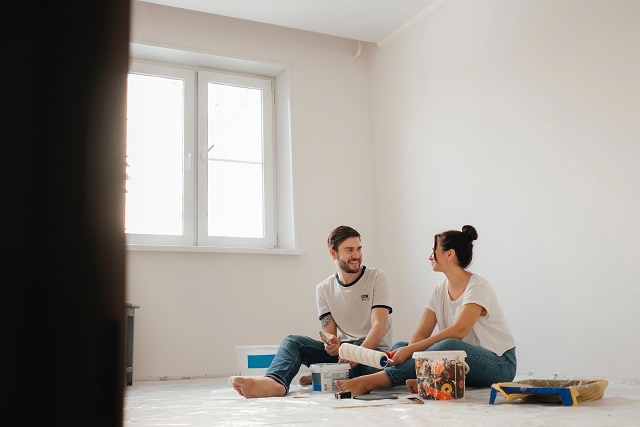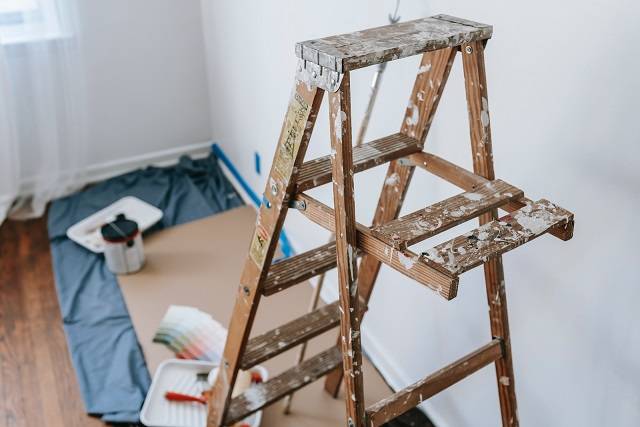Table of Contents
ToggleIntroduction
Painting your house is one of the quickest and most cost-effective ways to add personality, style, and energy to any home. But before you start stocking up on paint brushes and roller trays, let’s take a moment to review some common mistakes many homeowners make when they tackle painting projects themselves. From improper wall measuring techniques to overspilling onto surfaces where it doesn’t belong – everyone makes some mistakes from time to time – but with our tips for avoiding these common pitfalls, you’ll soon have beautiful, freshly painted walls that will stand the test of time!
Common Painting Mistakes You Should Avoid
When painting your house, it’s essential to take your time using the wrong side and do the job right to achieve the best results. Here are the top five mistakes to avoid when painting your house:
- Skipping Surface Preparation:
One of the most common mistakes homeowners make when painting their houses is skipping surface preparation. While jumping right into the fun part of applying fresh paint may be tempting, neglecting proper prep work can have disastrous consequences. Adequate surface preparation is crucial for ensuring a long-lasting and professional-looking paint job. It involves thoroughly cleaning the surfaces, repairing any cracks or holes, removing loose or flaking paint, and sanding smooth any rough areas. Skipping these steps can result in poor adhesion, peeling or bubbling paint, and an unsightly finish. Furthermore, failing to address underlying issues such as moisture or mould can lead to more extensive damage. By investing time and effort in proper surface preparation, homeowners can avoid costly and time-consuming mistakes while achieving a successful painting project that will beautify their homes for years. - Using Low-Quality Paint and Tools:
Using low-quality paint and tools can be a significant mistake to avoid when embarking on a house painting project. While the cost-saving aspect might seem appealing initially, it can lead to long-term issues and dissatisfaction with the final result. Low-quality paint lacks durability and may have uneven color pigmentation, resulting in a patchy finish. Moreover, its low adhesive properties can lead to premature cracking or peeling paint, requiring regular touch-ups or even complete repainting sooner than expected. Additionally, using inferior tools such as brushes or rollers can result in streaks, visible brushstrokes, or an inconsistent paint application. Investing in high-quality paints, whether water-based paint or oil-based paints, known for their longevity and smooth application is crucial, as well as utilizing proper tools like quality brushes and rollers to ensure a professional-looking finish that will stand up over time. - Ignoring Primer:
When embarking on a house painting project, it is crucial to understand the importance of using a primer before applying the paint. Ignoring this essential step can lead to a range of problems that may compromise the longevity and visual appeal of the finished product. Firstly, the paint might not adhere properly to the surface without using a primer, resulting in poor coverage and an uneven finish. Additionally, certain surfaces, such as bare wood or drywall, have different absorbency levels, and a primer helps create an even base that allows for better paint adhesion and color consistency. Moreover, ignoring primer can cause stains or discoloration from previous coatings to bleed through the new paint job. Furthermore, primers are vital in blocking moisture penetration, preventing mold growth and peeling or cracking of the paint. By taking the necessary precaution of priming before painting your house, you ensure a smooth application process and long-lasting results that enhance the beauty and durability of your home’s exterior or interior surfaces. - Overloading the Brush or Roller:
When embarking on a house painting project, avoiding the mistake of overloading your brush or roller is crucial. While drenching these tools in the paint may seem efficient, it often produces subpar results. One common consequence is an uneven application, with globs of excess paint causing an undesirable texture and finish on the surface. Moreover, this approach tends to result in dripping and streaking, leaving unsightly marks on walls or siding. Using moderate paint and evenly spreading it across the brush or roller can ensure smoother strokes and more consistent coverage. Too much paint can also lead to wastage as excessive amounts of paint may dry off the tool instead of adhering properly to the surface. Therefore, exercising control and applying paint judiciously will enhance the final appearance and conserve resources during your painting endeavour. - Ignoring Weather Conditions:
Ignoring weather conditions is a critical mistake to avoid when painting your house. It is imperative to consider the current weather forecast and temperature range before starting any exterior paint job. Extreme weather conditions such as high humidity, intense heat, or freezing temperatures can significantly impact the quality and durability of the paint. For instance, painting during high humidity can lead to slow drying times and potential moisture buildup beneath the paint surface, resulting in peeling or blistering over time. Similarly, applying paint in extreme heat can cause it to dry too quickly, leading to an uneven finish or visible brush marks. Moreover, cold temperatures can prevent proper curing of the paint, leaving it more susceptible to cracking or chipping. Therefore, professional painters always prioritize checking weather conditions beforehand and plan their projects accordingly to achieve satisfactory results that stand the test of time.
Bonus Tip:
Patience is Key: Rushing the painting process is a mistake that can lead to visible imperfections. Take your time to the paint brush, do the job properly, allow adequate drying time between coats, and be patient throughout the entire process. A well-done paint job will be worth the effort in the long run.
By avoiding these common mistakes, you’ll increase the chances of achieving a beautiful, long-lasting paint finish on your house. There are great professionals like Brisbane roof painting whom you can consult for a more professional finish.

FAQs
What should I do to prepare my walls before starting to paint?
Before painting your walls, it’s essential to properly prepare them to ensure your paint project has a smooth and long-lasting finish. Start by thoroughly cleaning the walls and removing dirt, dust, or grease using a mild detergent and sponge. Repair cracks or holes with spackling compound, allowing it to dry completely before smoothing the area with fine-grit sandpaper. For glossy or semi-glossy surfaces, lightly sand them to create a rougher texture to which the new paint can adhere. Next, apply painter’s tape along the edges of ceilings, baseboards, and trim to protect them from accidental paint drips. If you notice any stains or discolouration on your walls, consider applying a coat of primer before painting for improved color depth and uniformity. Finally, ensure the room is well-ventilated and cover furniture and flooring with drop cloths to avoid unwanted splatters. These steps will lay a solid foundation for a successful painting project and leave your surfaces fresh as ever!
How do I choose the right paint for different surfaces in my house?
When choosing the right type of paint for different surfaces in your house, there are a few factors to consider. Firstly, you need to assess the coat of paint surface itself. Is it a high-traffic area prone to scuffs and stains, or is it a low-traffic area where durability isn’t as important? For high-traffic areas such as hallways or kitchens, opt for a paint with a higher sheen, like satin or semi-gloss, as they are easier to clean. On the other hand, flat or eggshell finishes work perfectly fine for low-traffic areas like bedrooms or ceilings. Secondly, consider the material of the surface you’ll be painting on. If it’s wood, look for an enamel-based paint that offers better adhesion and protection against moisture. Alternatively, use rust-resistant paints specifically made for metal if you’re painting on metal surfaces. Lastly, always consider any environmental concerns and choose paints that are low in volatile organic compounds (VOCs) or even eco-friendly options if possible. By considering these factors when selecting paint types and finishes, your walls will look great and withstand the demands of everyday life in your home!
Can you provide tips on choosing the right paint color for each room?
When choosing the right paint color for each room, several factors must be considered. Firstly, consider the room’s purpose and its overall atmosphere. For example, a bedroom is often associated with relaxation and tranquillity, so choosing soft and soothing colors like pale blues or pastel purples can create a peaceful ambience. On the other hand, vibrant hues such as yellow or orange can energize a kitchen or a living room where socialization occurs. Lighting also plays a crucial role in paint colour – rooms with abundant natural light can handle darker shades like navy blue; however, if your space lacks natural light, selecting lighter tones will help brighten it up. It’s also worth considering the furniture and décor of each room; neutral colors serve as a versatile backdrop that complements various styles, while bolder color choices might require careful coordination. Trust your instincts and choose colors that resonate with you since you’ll spend time in these rooms – let them reflect your unique taste and personality!
Conclusion
Understanding home improvement projects is essential for any homeowner, painting being one of them. Always make sure to research the materials and techniques you’ll be using for your paint job, and be sure to prepare the area you’ll be painting properly. A thorough preparation will ensure a successful paint job. At the same time, never forget to take moisture into consideration as well as guarantee that you have adequate ventilation so that your painting environment remains safe and latex paint is healthy. Be aware of other contributing factors, such as lighting too. Thinking through all these points will save you time and money in the long run and ensure that your house looks no less than perfect with the perfect shade of paint. Ultimately, it is important to avoid making mistakes in painting to reach picture-perfect results.
Autobiography
Jim Pulman has extensive knowledge and experience in Home Building, Construction, and Design. He writes articles in his free time and partners with content creators to share his expertise with the online community







